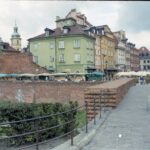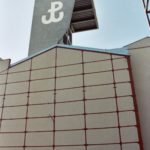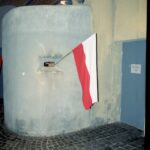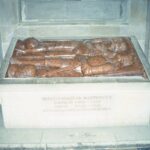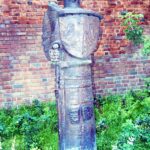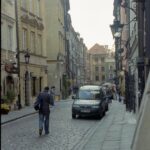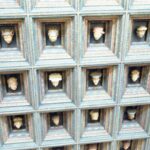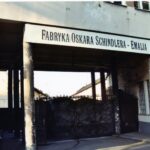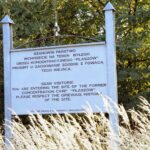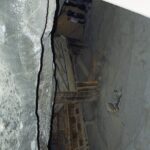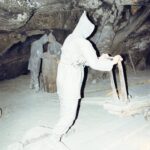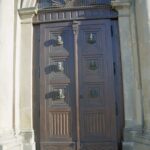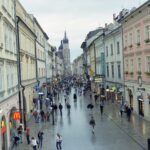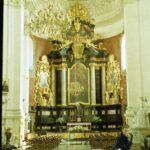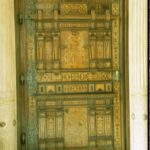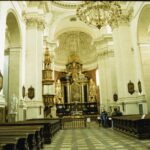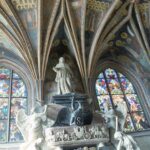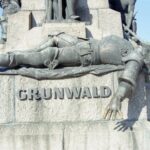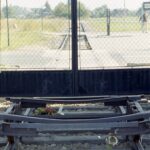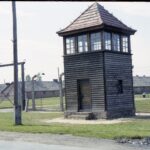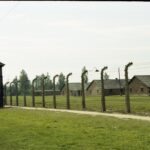
Poland
After our first trip together to Oktoberfest, Kelly and I decide we enjoyed traveling together and booked Budapest, Vienna, and Prague through Go-Today. We loved that trip and all three cities.
Austria uses the Euro but Hungary and Czechia don’t. We talked about visiting non-euro countries again because of the better exchange rates. We both wanted to visit Poland and Go-Today had a Warsaw-Krakow trip that included city tours, airport transfers, and the train between cities. Looking at their site recently, Poland is no longer listed at one of their destinations, sadly.
We flew from Bloomington to Chicago then had a flight to Amsterdam on September 11th.
We arrived in Amsterdam on time but we had a 4-hour delay leaving for Warsaw. After arrival in Warsaw I waited until all bags were off the carousel before leaving the baggage area. Fortunately, after reporting my bag missing, I was told my luggage was there and just had to go to another room to pick it up. I’m not sure if someone else had taken it by mistake and then turned it in or it got delivered to the wrong carousel, just glad I had it.
Warsaw
Our driver was waiting for us and took us to the Frederick Chopin Hotel in downtown Warsaw. We should have arrived around 1230 and it was close to 1730 by the time we got to the hotel. After freshening up a bit, we went out for a walk around town, nowhere specific, just wandering. We found a little brewery/restaurant for an excellent plate of a variety of pierogi’s and a couple beers before going back to the hotel, fairly early. It had been a long day of travel.
On Thursday, September 13th, our tour of Warsaw was at 0930. We were picked up in our lobby and went to a few other hotels for more people before starting the tour. Our guide was Pauline; she was very interesting and friendly.
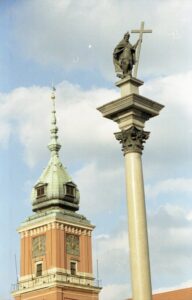 We saw the Monument to the Ghetto Heroes in the old Jewish Quarter, visited the island in the Vistula, saw the “Palace-on-the-Water” and the Chopin monument in the Royal Park at Lazienki, then the Royal Castle.
We saw the Monument to the Ghetto Heroes in the old Jewish Quarter, visited the island in the Vistula, saw the “Palace-on-the-Water” and the Chopin monument in the Royal Park at Lazienki, then the Royal Castle.
We visited the Zygmunt Kolumna, or Sigismund Column, erected in 1644 for King Sigismund III who moved Poland’s Capital from Krakow to Warsaw. It was the first non-religious monument “allowed” in Warsaw.
We went to Old Town Square or Stare Miasto, the Barbican, Chopin Museum, Madame Curie Museum (a Polish woman who “just” married a Frenchman) in the home where she was born. We saw the Wishing Bell. We attended a short organ “concert” at St. John’s Cathedral. We heard a lot of interesting information on the town history.
Later, after our busy morning on the tour, we ate some more pierogis at Pierogarnia. We stayed in Old Town after lunch. We returned for a visit to the inside of the gorgeous Royal Castle, before visiting the Warsaw Uprising Museum which was open late on Thursday’s. We walked across town, arriving just before 1800 and stayed until closing at 2000. The museum, opened in 2003, was one of the most interesting things we saw in Warsaw.
At the very start of WWII, the Germans had prepared secret plans to raze Warsaw to the ground and build a “purely German city”. From 1940, when they established the Jewish Ghetto, through the Ghetto Uprising of 1943, to the murders in the Treblinka death camp, the people of Warsaw were targeted by the Nazi’s.
The Polish Resistance movement and the underground Home Army launched the Warsaw Uprising on 1 August 1944, in an attempt to liberate the city from the Nazi’s as well as prevent the communists, the Red Army that was approaching from the East, from taking over. After two months of intense fighting the city surrendered. Almost 200,000 Poles died in the uprising and this fascinating museum tells their story, how the Nazi’s systematically burnt and bombed 85% of the city while the Red Army watched and prevented the Allies from helping. The Soviets had already planned their post-war strategy for Poland.
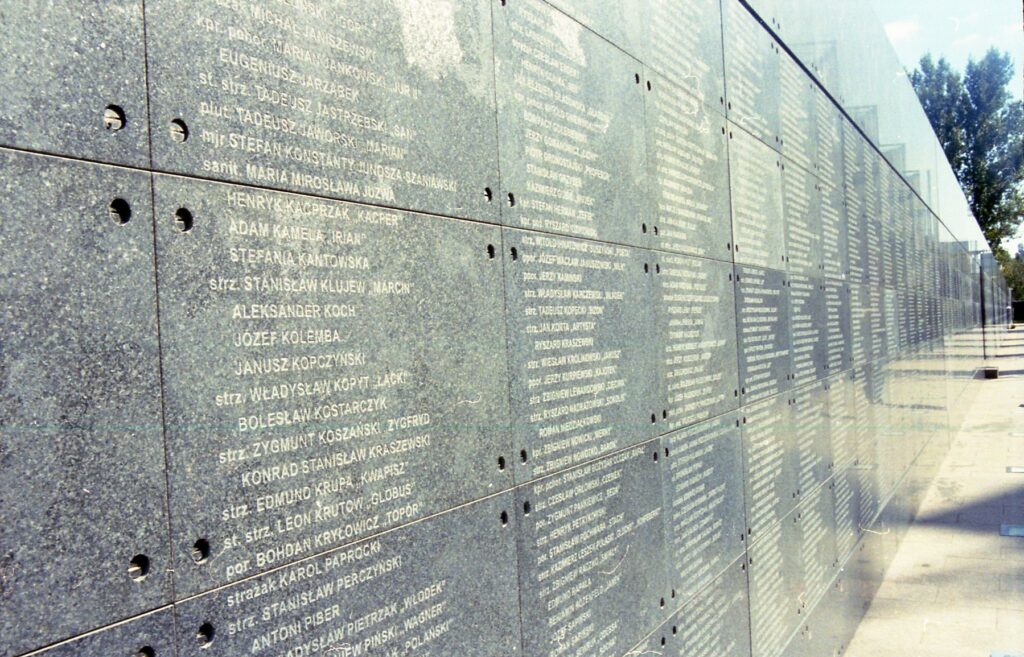
Since we had only seen about half the museum yesterday we both wanted to go back, so that was our first stop on Friday. After a late breakfast we went directly to the museum and got there when it opened at 1000. We stayed until about 1300.
We tried some excellent layered cheesecake on the outdoor patio before leaving, for a very healthy lunch. We walked across town stopping at a variety of sites. We tried going to Pawiak Prison, now a museum, but it was closed until December.

We saw the Monument to the Warsaw Uprising, located at the entrance to an old canal used by the Polish fighters to escape the Germans. The monument, a 33-foot-tall bronze sculpture, is in two parts. One shows fighters crawling out from underneath a bridge while the other shows them heading into the canal. They used the canals to move around the city, escaping the German soldiers.
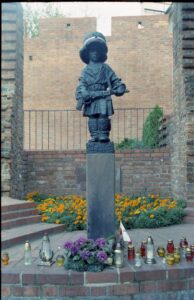
We also saw the Monument to the Young Insurgent, or Maly Powstaniec, designed by Jerzy Jarnuszkiewicz. It is dedicated to the child soldiers who helped during the uprising.
We visited the gardens of Krasinski Palace and the beautiful Deluga and Miodowa Streets with lots of great old buildings as we walked to Old Town, Stare Miasto.
We walked down the Royal Way. It was difficult since so much was blocked off and the entire street was torn up. Sidewalks on both sides of the street were open, however, and we saw all the great architecture and churches. We found a great little restaurant and had a leisurely dinner trying some new things recommended in our ‘Eating in Poland’ Guide. Kelly got the beet soup, the barszcz, and I tried the sour rye with ham then we both had some good pork.
Saturday, September 15th, we wanted to see the movie at the Warsaw History Museum, recommended by Pauline and the guide books, which was showing at 1200 so we planned our day around that visit. The museum is huge, with many interesting and varied exhibits.
We had lunch at Pierogarnia again, this time I had ‘pierogi ruskie’ or Russian pierogies with cheese & onion. We decided to go across the Vistula River to visit the Praga district. We tried visiting the Wedel Chocolate Factory but it was closed. We saw St. Florian’s Cathedral, the Orthodox Church of St. Mary Magdalene, and the Red Army Monument. There was so much more to see, but we didn’t have a lot of time. We walked up to New Town Square which we hadn’t visited yet and had dinner.
We were scheduled to be picked up around 1130, Sunday the 16th, to catch the 1205 train to Krakow. We had time that morning to visit the Palace of Culture & Science, “Stalin’s gift to Warsaw”. The building is very controversial, and lots of Varsovians hate it. It wasn’t a beautiful building but it wasn’t as hideous as Pauline said it was. We visited the terrace for great views of the city then returned to the hotel to wait for our pick-up.
Krakow
First class seats and seat assignments for the train were included with our booking, conveniently, so we were able to board with no wait. We arrived in Krakow around 1450 and were picked up from the station and taken to our hotel.
Hotel Alexander was in a great location, just a few blocks from Old Town and we had a nice big room with a mini-bar. I could buy some drinks and have them cold. We headed out to explore after dropping off our bags and stopped down the street for a late lunch at a little cafeteria. We ate light so we wouldn’t be having dinner at midnight.
We walked the wrong way after leaving the hotel, because our city map showed the hotel on the opposite side of the street but after a few blocks we corrected ourselves and figured out where we were. We wandered through Old Town Square, Rynek Główny, huge and beautiful and the center of town. At 10 acres, it is one of the largest central squares in all of Europe.

We visited the incredible Saint Mary’s Basilica. All the guide books call it magnificent and it was. The altar, by Veit Stoss, is considered Poland’s greatest masterpiece of gothic art. Also on the square is the great “Cloth Hall”. Basically, a covered shopping area, it has been in the square for 700 years. A roof was built over the first two rows of stalls where textiles were traded. The shopping area was expanded in the 14th c. We wandered through here a couple times and I found a beautiful pair of amber and silver earrings that I still wear. There is a museum of Polish art on the second floor.

Like most city squares in Europe, there are plenty of restaurants with outside seating. We had a late dinner on the square and had some good Zywiec beer then went back to our hotel.
We had our tour of the city, Monday, September 17th. We started off around 0920. Our guide was very knowledgeable, and had actually helped Steven Spielberg with “Schindler’s List” research. She was rather hard to understand, however, because of a very heavy accent. There were about twenty people on the tour, so it was also hard to get close and hear her. After a while I didn’t listen that much, just enjoyed the sites and looked info up in my guidebook.
We visited Szeroka Place in the old Jewish district of Kasimeirz, named after the king who welcomed Jews to settle in the area. We heard about the history of the district and the Jewish community both before and after the war. We went on to Wawel Hill where we visited the Cathedral.

It was very, very crowded and you could barely see anything with all the people. We did get to climb the Sigismund Tower to see all the bells. The largest, Sigismund Bell, from 1520 is the largest in Poland. It was a fun but narrow climb. After the Cathedral we saw the Royal Chambers and had some time on our own to walk through more of the castle. There were amazing rooms, some with cordovan leather walls. As usual, I enjoyed the rooms themselves, the architecture and the furniture, more than the paintings or other artwork. One room had an amazing ceiling covered with wooden heads.
After leaving the Royal Chambers, we met up with our group but then I stopped for a picture and delayed us so Kelly and I lost the group. I felt really bad about her missing the rest of the tour. They were going to Old Town to visit St. Mary’s, which we had already seen, but I’m not sure where else they were going or what we missed.
We tried to find them but didn’t see anyone after rushing down the hill, so we just relaxed with a drink on the patio and enjoyed the view over the river. We visited the Dragon’s Cave, 135 steps through the cave leading from castle hill down to the banks of the river. Legend tells of Prince Krak, who killed the dragon to protect the city.
We walked through the park and north back to Old Town, had a quick lunch then bought tickets to go to the Town Hall Tower for good views of Old Town. The tower is all that is left of the old town hall built in the 13th and 14th centuries.
We had purchased tickets that morning at the Krakow Tour Company for the afternoon tour of “Jewish Traces and Schindler Site’s” and the Auschwitz tour for tomorrow morning. Our guide, Conrad, for the Schindler tour, was friendly and interesting. It was just Kelly and me and a Scottish couple and their teen-age daughter on the tour. We were driven back to Kasimeirz from their tour office then spent some time walking through the area. We heard more details on Jewish history in Poland and Krakow, the ghetto, the Belzec Camp, we visited Schindler’s factory, still standing and now a museum, and the site of the Plaszow concentration camp.
Plaszow is a mostly empty field with a single stone monument. It was the site of two former Jewish Cemeteries; the Germans liked to build on these sacred locations to further insult the Jewish people. The Germans razed everything in the camp to the ground in an attempt to hide their crimes. We also saw Amon Goeth’s house, the evil commander of the camp who was featured in Schlinder’s list. We finished up at Jagiellonian University, right at Old Town. We walked back to the hotel for a rest then went back out to dinner.

On Tuesday, the 18th, we were up at 0630 for our tour at 0800. The tour included the bus to Auschwitz. Only about 36 km to the town of Oswiecim, which the Germans called Auschwitz, it takes about an hour to get there from Krakow. We viewed a movie on the drive, made by Russian war journalists who were with the Russian army that liberated the camp. Amazing video and so sad. It gave a lot of history of the camp to prepare us for our visit. 75% of the people who arrived at the camp were immediately separated from the “healthy workers” and killed.
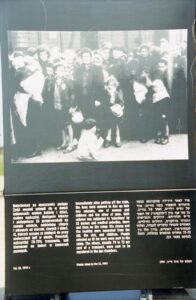 We visited the barracks and saw the items the Germans stole from their victims and hadn’t yet shipped back to Germany, an entire barracks of hair, their shoes, and suitcases. This more than anything, was so powerful, to see all these items piled up behind glass. We returned from Auschwitz around 1400 then walked back to our hotel just a few blocks from the tour company.
We visited the barracks and saw the items the Germans stole from their victims and hadn’t yet shipped back to Germany, an entire barracks of hair, their shoes, and suitcases. This more than anything, was so powerful, to see all these items piled up behind glass. We returned from Auschwitz around 1400 then walked back to our hotel just a few blocks from the tour company.
We dropped off some items, and had lunch, a beer and a kebab. It was really a gyro but they called it a kebab. After lunch we went to see the Silesian House, the former Gestapo HQ. There was an interesting display of items about the Polish Resistance, then we visited the cells in another building where you can still see all the messages scraped into the walls by the prisoners.

We visited St. Florian’s Tower, part of the wall by the Barbican. This is the only original gate still standing, out of the eight built in the 14th century. Our ticket for the museum also allowed us to visit the Barbican but we didn’t realize that until a couple days later so we missed that. There was an interesting display of all the former gates into the city on the wall, all named for the different guilds who built the gate and were in charge of defending them, for example the candlemakers, silversmith, and cobblers. We did a little shopping at Old Town, checked email at an Internet cafe (pre-smart phone days!) then had dinner and called it a night around 2100, since we had been up early.
We slept in on Wednesday, September 19th, we were up around 0830 and out about 0930. We went down to the Kazimeirz district. We stopped on the way so I could use up my Black & White film roll from Auschwitz, most photos didn’t come out anyway, unfortunately, but it was an old roll of film.
We also passed the churches of Saints Peter and Paul and Saint Andrew’s. The Church of Saints Peter and Paul, built in 1622, had life-sized statues of the twelve apostle’s on the fence in front and a beautiful facade. The interior was equally gorgeous. Saint Andrew’s, from the 11th c, one of the city’s oldest churches, was also very ornate.
After arriving at Kazimeirz, we visited the museum in the Old Synagogue and the Remuh Cemetery. We walked up a few blocks to Isaac Synagogue to see the two historical documentaries we had read about, but they were no longer being shown.
We went back to the square and had an excellent, light lunch at a restaurant Kelly had read about. Klemzer Hois, in the old Jewish Bath house, is now a restaurant and hotel.
After lunch, we went to the Galicia Jewish Museum. We spent several hours here. It documents, via powerful photographs, Jews during the war, the Resistance, and after the war showing all the ruined Jewish monuments and buildings. We stayed several hours then walked to the Ethnographical Museum, which was unfortunately closed for a couple weeks.
We visited the Corpus Christi Church, built in 1340, just a block away, before returning to Old Town. We stopped at the Krakow Tour office again to pick up tickets to the Salt Mine before heading to the hotel. Kelly went to the Equestrian shop we had seen early buy some reins. We met up and headed back out to the Czartoryski Museum which was open late.
We stayed until almost closing at 1900. It was a great museum, it had a variety of items collected by the royal Czartoryski family for over a hundred years, from Turkish weapons to mummified birds, Greek vases, Roman statues, and a da Vinci, “the Lady with the Ermine”. We had a late and long, leisurely dinner. More great barszcz beet soup that we both loved, pork roast, potatoes, and local beer.
We were up around 0830 on Thursday. After another good breakfast in the hotel, we went up to Wawel again. There was no tour of the Private Apartments, which we wanted to see, until 1320 so we just visited the cathedral again. It wasn’t quite as crowded, as it was early, and we saw more of the building.
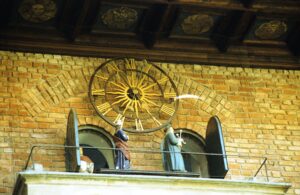
Jagiellonian University is one of the oldest in Europe, founded in 1364, by King Casimir. It was where Nicolaus Kopernik, or Copernicus, attended school. We walked around the campus and visited Collegium Maius, Poland’s oldest surviving university building, dating from the 15th c. We stayed to see the clock in the courtyard of Collegium Maius, showing professors and kings.

We should have booked tickets further in advance; while we did get to see the standard rooms which were beautiful, we couldn’t get tickets to the Ancient & Modern Science Museum. Our tickets were for an hour later, so after viewing the clock tower at 1100, we headed to the square for a beer break before going back for our tour. We read about this “self-serve” restaurant in the book so headed there for lunch after the tour. On the way, I had found a shop selling Christmas ornaments and bought a beautiful blown-glass ornament.
After lunch we headed back to the hotel to drop off some items and pick up jackets before heading back out; we were told the mine could be quite cool. We did a little shopping in Old Town, found a bakery and had some fabulous cakes, then went to the tour office for our tour of the Salt Mines. We had a short bus trip and guided tour of the mine. It is about a 20-minute drive from Krakow.
Kelly and I both had the Wieliczka Salt Mine on our “must-see” list in Krakow. A working salt mine for more than 700 years, it has nine levels, goes down to 327 meters, has 2040 chambers connected by 200 kilometers of passages. We had a two-hour tour so only saw the highlights, obviously.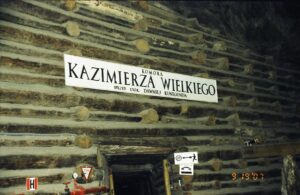
“The Legend of Saint Kinga is as old as the mine itself. A long time ago, the Polish prince Bolesław the Chaste asked his chosen one, the Hungarian princess Kinga, to marry him. As an engagement gift, he gave Kinga a beautiful ring. When the princess left her homeland for Poland, her father, King Bela IV, wanted to offer her daughter an appropriate dowry. However, Kinga wanted neither jewels nor a retinue of servants. Instead, she asked her father for salt, which was a rarity at the time. She wanted to bestow her new subjects with it. And so the king of Hungary gave his daughter the richest mine in Transylvania, Prajda. But this gift did not satisfy Kinga, as the mine was too far from her new kingdom. Before leaving for Poland, she visited the tabernacle she had been given, and contemplated how to transport the salt to Poland. During this visit, she tossed her engagement ring into one of the shafts while praying. When Kinga arrived in Bolesław’s country, she set off on a tour of the kingdom. While visiting a small village near Krakow, a lump of salt was found in the field. Inside the lump was a ring – the same one that the princess had thrown into the shaft in Prajda. Kinga and Bolesław commanded to begin digging in this location, and discovered more valuable raw material underground. Hence the emergence of the Wieliczka Salt Mine.”
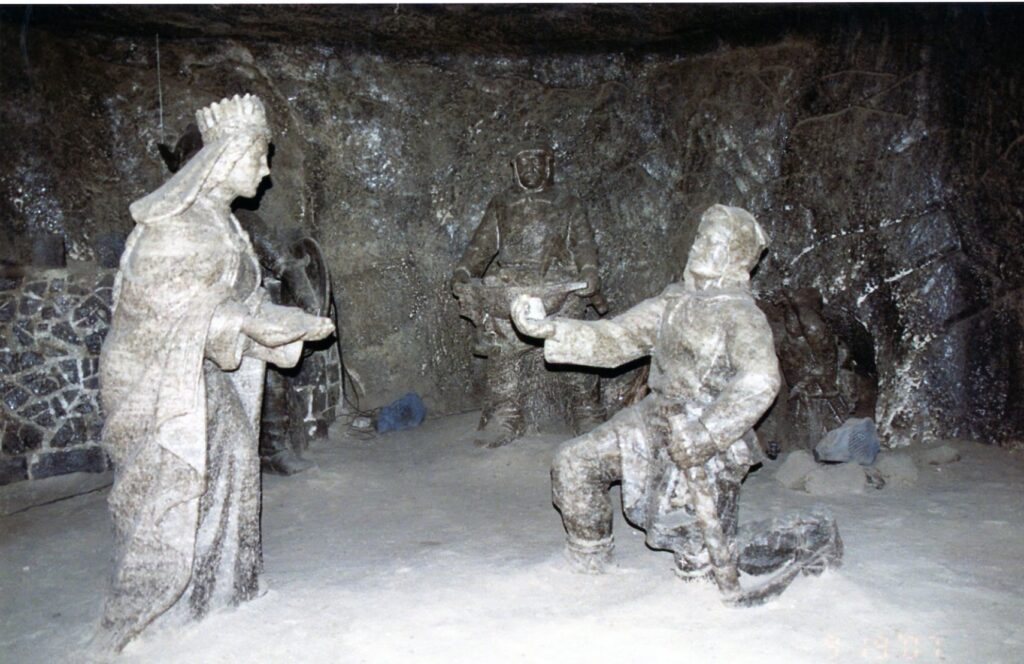
The chapel of the Blessed Kinga is the largest room in the mine. It took 30 years to complete. We saw a life-size carving of Pope John Paul II, all from salt and many other amazing salt carvings. The mine became a World Heritage site in 1978.
We arrived back in town around 1930 and we wandered around looking for a restaurant we had seen earlier in the week. We never could find it even after looking for about an hour but had a good dinner anyway. We went back to the hotel to pack and headed home early the next morning.
We both loved these beautiful and interesting cities, the history is amazing. I am so glad Kelly likes visiting history museums and historical sites as much as I do.
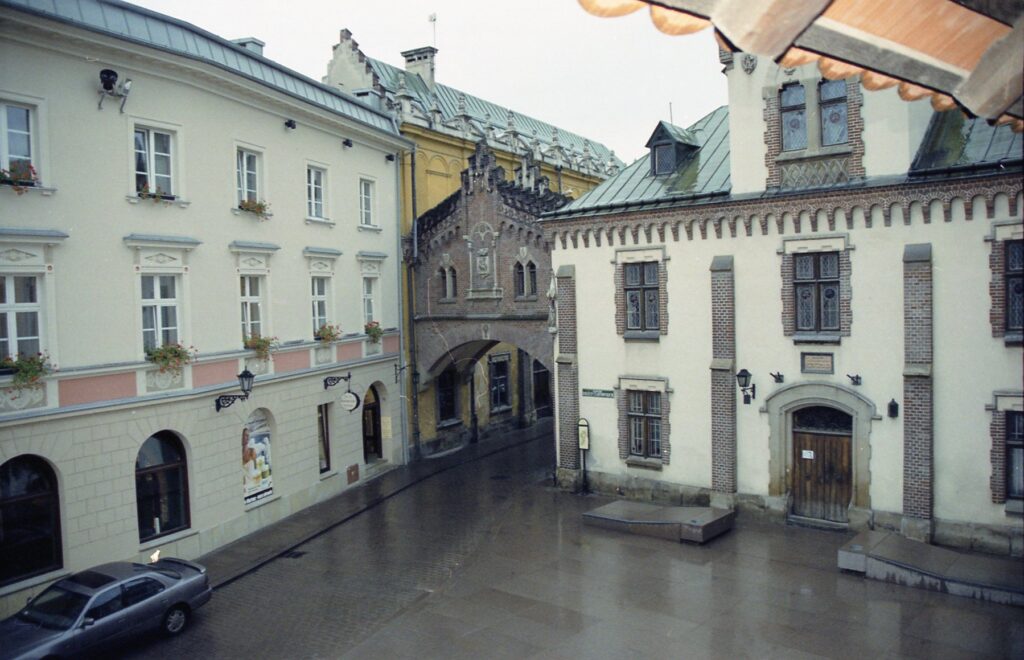

Facts about Auschwitz
All over the world, Auschwitz has become a symbol of terror, genocide, and the Holocaust. It was established by the Nazis in 1940, in the suburbs of Oswiecim, a Polish city that was annexed to the Third Reich by the Nazis. Its name was changed to Auschwitz.
Between 1,100,000 to 1,500,000 people died at these camps, the majority in the gas chambers.
There were 40 subcamps and work camps around Auschwitz I, Auschwitz/ Birkenau II and Auschwitz/Monowitz III.
“We must free the German nation of Poles, Russians, Jews and Gypsies” – Otto Thierack, Minister of Justice of the Third Reich
The factories and workers at these camps were vital to the German war effort. Only the young and healthy were kept as slave labor. 75% of people arriving at Auschwitz immediately went to the gas chambers.
“Time has no power over these memories” – an Auschwitz survivor
293 sacks of hair, over 15000 pounds were found at the camp when liberated. The Nazi’s shaved their victims and used the hair for rope, mattresses and other raw materials.
“The nights are a torment. I often dream I am in Auschwitz” – an Auschwitz survivor
Historians estimate that among the people sent to Auschwitz there were at least 1,100,000 Jews from all the countries of occupied Europe, over 140,000 Poles (mostly political prisoners), approximately 20,000 Gypsies from several European countries, over 10,000 Soviet prisoners of war, and over ten thousand prisoners of other nationalities. The majority of the Jewish deportees died in the gas chambers immediately after arrival. Over 50% of the registered prisoners died as a result of starvation, labor that exceeded their physical capacity, executions, living conditions, disease and epidemics, punishment, torture, and criminal medical experiments.
Jews were 90% of the victims of these camps.
“Their indifferent, cold eyes filled us with shame” – Russian soldier, liberator, on seeing the survivors of the camp.
** All photos property of Lisa (except where indicated from online sources) **

